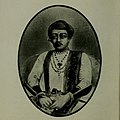| Image | Name | Birth | Reign | Death | Notes |
|---|
 | Balaji Vishwanath (Sixth appointed Peshwa) | 1 January 1662 | 16 November 1713 – 12 April 1720 | 12 April 1720 | Assisted the Syed Brothers in deposing the Mughal Emperor Farrukhsiyar in 1719 |
 | Baji Rao I (Seventh appointed Peshwa) | 18 August 1700 | 17 April 1720 – 28 April 1740 | 28 April 1740 | Known as Thorle (elder) Bajirao and acknowledged as the most influential of the nine Peshwas. Said to have fought for the establishment of "Hindu Pad Padshahi"(Hindu Empire). Helped conquer Central India (Malwa) and Rajputana and extended his dominions into Gujarat in the northwest and Deccan in the south. Attacked Delhi in 1737. Fought in over 41 battles and is one of the few to have never lost a single battle. Died at the age of 40 of sudden fever in camp en route to Delhi; he has been commemorated in the form of an equestrian statue erected at Shaniwar Wada in Pune. |
 | Balaji Bajirao (Eighth appointed Peshwa) | 8 December 1720 | August 1740 – 23 June 1761 | 23 June 1761 | Known as Nanasaheb Peshwa. Managed to extend the Maratha territories into most of North-West, East and Central India. Captured Attock on the banks of the Indus River and Peshawar in 1758 in the Battle of Attock, 1758. Under his leadership, the Maratha Empire reached its peak but his general and cousin lost the Third Battle of Panipat against Ahmad Shah Abdali in 1761. Contributed to the development of the city of Pune which was the seat of the Peshwas. Built the famous Parvati Temple, Lakdi Pool and established Nana Peth (area) in Pune. Built a water reservoir near Katraj to provide clean water to Pune city; this 250-year-old system is still functioning. |
 | Madhavrao I (First hereditary Peshwa) | 15 February 1745 | 23 June 1761 – 18 November 1772 | 18 November 1772 | Fraught with internal dissensions and successful Wars with the Nizam. During his tenure, Maratha power recovered from the losses suffered during the Third Battle of Panipat, a phenomenon known as Maratha Resurrection. Repaired the recently weakened administration, treasury, and accounts of the Maratha Empire. He died of tuberculosis in 1772; a memorial commemorating his greatness stands at Peshwe Park in Pune. One of the theory says that he was assassinated by her aunt, Anandi Bai (wife of Raghunath Rao). |
 | Narayan Rao | 10 August 1755 | 13 December 1772 – 30 August 1773 | 30 August 1773 | Assassinated by Gardi guards. Raghunath Rao was in favor of just kidnapping him and accordingly he used the code "DHARA". But Anandi Bai (wife of Raghunath Rao) changed the code to "MAARA". Narayan Rao was assassinated in Shanivar Wada. Nowadays, it is considered one of the haunted place in Maharashtra. |
 | Raghunathrao | 18 August 1734 | 5 December 1773 – 28 May 1774 | 11 December 1783 | Responsible for extending the Maratha empire to the zenith in the North as a General and also saw the decline of Maratha power in North India. Deposed by Nana Phadnis and 11 other administrators in what is now called "The Baarbhai Conspiracy" |
 | Madhavrao II | 18 April 1774 | 28 May 1774 – 27 October 1795 | 27 October 1795 | Appointed Peshwa as an infant with a council of Maratha Generals and ministers as regents. Era dominated by the political intrigues of Nana Phadnis. Saw the resurgence of Maratha power in North India. |
 | Baji Rao II | 10 January 1775 | 6 December 1796 – 25 October 1802 | 28 January 1851 | 1st Reign – Was defeated by Yashwantrao Holkar, ruler of Indore, at the Battle of Poona. Fled to British protection, and in December 1802, concluded the Treaty of Bassein with the British East India Company, ceding territory for the maintenance of a subsidiary force and agreeing to treaty with no other power. This provoked the Second Anglo-Maratha War that began the breakup of the Maratha confederacy. |
| Amrut Rao [9] [10] (Appointed as Peshwa by Yashwantrao Holkar) | c. 1770 | 25 October 1802 – 13 May 1803 | 6 September 1824 | Appointed Peshwa by Yashwantrao Holkar after defeating Baji Rao II and Daulat Rao Sindhia in Battle of Poona. |
 | Baji Rao II | 10 January 1775 | 13 May 1803 – 3 June 1818 | 28 January 1851 | 2nd Reign – During his second reign began the Third Anglo-Maratha War. After the defeat at the Battle of Koregaon in January 1818, he was on the run from the British. Eventually, the British took over his dominion and made the Maratha King Pratap Singh of Satara declare in favour of the British. This ended the Peshwa's legal position as head of the Maratha confederacy. On 3 June 1818, Baji Rao surrendered to the British; he was banished to Bithur near Kanpur. |
 | Nana Sahib
(Pretender of the position of the Peshwa) | 19 May 1824 | 1 February 1851 – 30 June 1857 (unrecognized) | after 1857 | Was a leader during the Indian Uprising of 1857. As the adopted son of the exiled Maratha Peshwa Baji Rao II, he sought to restore the Maratha confederacy and the Peshwa tradition. |


























